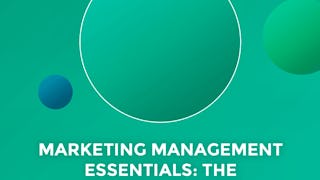Marketing is the lovely art and science of making it easy to buy. This has become a lot harder with global competition, glut of advertising, higher customer expectations, and overall rising quality of private label. There are a dozen frameworks (4P, STP, purchase funnel, content marketing, NPS) that will help you understand, wrestle, and apply marketing smarts to your work.



Mastering Business Essentials: Marketing
This course is part of MBE Mastering Business Essentials Specialization

Instructor: John Kim
Top Instructor
Access provided by Koç University
Recommended experience
What you'll learn
Explain marketing mix simply to your cousin. Use STP to target customers. Identify the optimal marketing communication message for customers.
Skills you'll gain
Details to know

Add to your LinkedIn profile
See how employees at top companies are mastering in-demand skills

Build your subject-matter expertise
- Learn new concepts from industry experts
- Gain a foundational understanding of a subject or tool
- Develop job-relevant skills with hands-on projects
- Earn a shareable career certificate

There are 6 modules in this course
The 4Ps framework is simple and useful; it covers the basics of the marketing mix. a) What is the PRODUCT / service you are selling and who are you targeting? b) How are you PRICING it to reflect your positioning? c) What PLACES do offer it - offline, online, globally? d) How are you PROMOTING your product (and its much more than advertising). Marketing is an expansive topic, but ultimately, it's about matching supply (you) with demand (customers). It's about making it easy for customers to buy (right PRODUCT, right PRICE, right PLACE, and right PROMOTION). Finally, Seth Godin - marketing leaders - says "Marketing is no longer about the stuff that you make, but about the stories you tell."
What's included
3 videos2 readings
Price is the only “P” that brings in revenue. Everything else is a cost. So it matters a lot. How much will your customers pay? What should you charge to reflect your product’s value, your brand, and your strategy? How do you balance raising prices (to increase profitability) without limiting volume (because people find it too expensive)? Price is strategic because it reflects a lot of information: customer's willingness to pay, competition, and your position in the customer's mind. Pricing is dynamic and changing; companies continually experiment with discounts, promotions, and bundling to capture the most about of value (and profits), while keeping customers happy and coming back.
What's included
3 videos2 readings1 assignment
Place = distribution. This is where marketing has to coordinate with supply chain so that we are getting the right products, in the right quantity, delivered to the right places. In the past, it was simple: ship the products to the stores and wait for customers to come. Now, it's mobile apps, home delivery, curbside pickup. Now, it's OMNICHANNEL, all the time. Promotion = marketing communication. As consumers, we are exhausted by the flood advertisements shouting at us. To earn our attention, marketers need to be more thoughtful and relevant. Whether it’s SEO (Google AdWords), podcasts, or influencer campaigns, the goal is the same: move the customer from awareness to action without wasting time or money.
What's included
3 videos2 readings
People are different; there is no such thing as "an average customer." STP (segment, target, position) is a way to think who your ideal, target customer really is. a) Segment people into different groups b) Target 1-2 specific groups (not everyone) c) Position yourself in the minds of customers, so that what they need is what you have. Stop talking to everyone and start persuading someone. Also, each customer is at a different stage of the purchase funnel. Some are just prospects who are AWARE of you, or show some INTEREST. Others may CONSIDER for a specific job, or every TRY your product. Others are now customers who PURCHASE, and REPURCHASE because they love you.
What's included
2 videos2 readings1 assignment
As Peter Drucker said, "The purpose of a business is to create a customer." So the question is how do you get new customers (e.g., STP and purchase funnel) and how much does it cost to acquire customers? Every billboard, radio spot, social media post, or advertisement costs money. How much does it cost to acquire a new customer (CAC)? One we have a lovely customer, we should try to keep them. Often, a long-term customer is the most profitable because you don't have to spend more money on CAC; you already "acquired them".
What's included
2 videos2 readings
Word-of-mouth marketing has always been important. After all, when your best friend (who really understands your thinking and interests) recommends a movie - you definitely want to watch it. This has only become more important as we are flooded with different brands, products, and advertisements. After all, who should we trust and what should be buy? As a result, content marketing (sharing what you know and letting customers "try" a sample of your work) is the best way to build credibility, experience, and a faithful audience. Content marketing takes time, but it's the slow and foundational way to build a business.
What's included
3 videos2 readings1 peer review
Earn a career certificate
Add this credential to your LinkedIn profile, resume, or CV. Share it on social media and in your performance review.
Instructor

Offered by
Why people choose Coursera for their career




Explore more from Business

University of Washington

IE Business School

Kennesaw State University
¹ Some assignments in this course are AI-graded. For these assignments, your data will be used in accordance with Coursera's Privacy Notice.


